The following is an excerpt from a book on stream
fly fishing for trout currently being written by Michael Gorman.
Fly Fishing Equipment Basics
by Michael Gorman
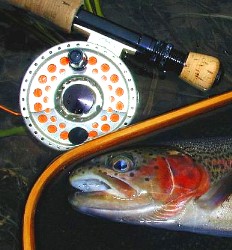 The
Hamm’s Beer Commercial The
Hamm’s Beer Commercial
“From The Land of Sky Blue Wa-a-a-ters comes the beer refreshing . . . Hamms,
the beer refreshing. Hamms!” This commercial refrain was sung on television
when I was a kid. The tune was cleverly catchy, but what drew my intense
attention was the scene of a fly angler standing in the middle of a beautiful
mountain stream casting a fly rod as the beer is advertised. When the line is
extended on the final forward stroke the fly lands immediately in front of the
camera lens held at water level. The artificial drifts a short distance when
suddenly a trout charges through the surface to grab the fly. To a young fish
killer this was an exciting moment. My very favorite commercial. I always
watched it with high anticipation. The trout always got the fly. Someday
I would be that fly fisherman.
My moment to graduate to a higher level of fishing consciousness soon arrived.
In the summer of my fourteenth year I pedaled my Schwinn American --- ruby red,
and very fast --- to my local sporting goods store. Summer work had allowed me
to set aside enough cash to buy a fly fishing outfit and some flies.
As for research, I had done none. A couple of my
uncles had talked about having done some fly fishing in their younger years, but
neither had ever demonstrated their skills. Besides, each had lost his religion
to consort with a spinning rod.
My local library was of little
help. It had but one fly fishing text which centered on fly fishing for
steelhead. The book went home with me for a brief stay. I was a trout
fisherman. There was little which was helpful I could glean from the text to guide me in
the selection of fly fishing gear to suit my needs. So, the book was soon
returned to the Stayton Public Library. There was no chance I would be billed
at the rate of ten cents a day for an overdue text.
As I strolled the main aisle
of my local sporting establishment to buy my first fly rod I, naturally,
examined the price tags. Assuming all fly rods are essentially created equal, I
chose the least expensive of the lot. Fly reel --- same thought process and
selection. I got a real deal on the fly line: 98 cents. I already had
thousands of yards of monofilament at home, so there was no need to buy a leader
since I had no suspicion that a leader should be tapered. Ah, now to the flies.
I made a studied perusal of
the fly bins, and then politely asked for suggestions. My hope was that the
patterns that held some visual appeal for me would be confirmed by the store
owner. Nope, didn’t happen. He suggested an assortment of drab looking fur and
feather concoctions. Even tried to sell me a fly he had tied using some of his
young son’s hair in the wing. Maybe not
coincidentally, the boy had been named after a fish: Marlin. So, after thanking
him for his suggestions I pro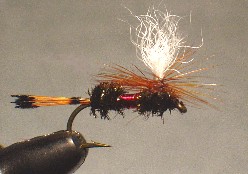 ceeded
to select a handful of artificials that suited my taste. The sole criterion was
that the fly be pretty. I was particularly fond of flies that had red floss somewhere on
the body. Among my other feathered dandies, the Royal Coachman was the runaway
winner in the “pretty” category. ceeded
to select a handful of artificials that suited my taste. The sole criterion was
that the fly be pretty. I was particularly fond of flies that had red floss somewhere on
the body. Among my other feathered dandies, the Royal Coachman was the runaway
winner in the “pretty” category.
After paying for my collection of items, I inquired about the
basics of fly casting and fly fishing technique. The shop owner queried “Do you
know how to fish a salmon egg on a spinning rod?” Little did he know of my
angling prowess. I humbly replied,
“Yes.” To my relieved amazement he finished with “Well, you a fish a fly the
same way you would a salmon egg.” Fly
fishing was going to be fun . . . and easy.
Is
it “bird nest, or “bird’s nest”?
After a hasty
assemblage of my new fly fishing outfit at home, it was time to practice casting
in the backyard. Back & forth, back & forth, let it rip. Forth & back, forth &
back & forth, let it rip harder. Next time: FASTER, HARDER. My initial fly
casting attempts were as successful as training a cat. The more enthusiastic my
efforts, the more disastrous the results. Line, leader and fly would fall
together in a tangled nest a few feet beyond my rod tip. Sometimes it was just
line and leader. A whip-cracking sound was often accompanied by the
disappearance of the fly once tied on the end. I whirling lawnmower blade would
eventually find it, but I would not.
Then an interesting thing happened. As my casting arm grew
weary and weaker the better my casts became. They graduated from grossly
pathetic to merely bad. Then, from bad to poor. I was making progress.
Lighten up on the power, shorten the arc of the waving rod tip, and the line
would sometimes land fairly straight without tangling. Hope emerged.
The next ten years found me vacillating somewhere between
exhilaration and throwing the fly rod javelin into the trees. Often I parked
the fly rod in the closet and took my dependable Old Friend, the spinning rod,
on my angling adventures. Sometimes the fly gear did not see the light of day
for months, even during the prime of the fishing season. It was a fickle
affair. My casting ability leveled off at mediocre, and my fish-catching
results were inconsistent. I blamed these on my lack of fly fishing athleticism
and my inability to find the one, true Magic Fly. Not once did I suspect that I
might have mismatched my rod, reel and line combination, or purchased inferior
equipment unable to perform well under ANY circumstances.
It wasn’t until graduate
school at OSU that I met another fly angler. His experience far exceeded mine,
and he talked a good game. We agreed to fish the Middle Deschutes in late
spring, in pursuit of brown trout and rainbows.
Fishing was slow but we
each brought a couple of brown trout to net. During a mid day break my new
friend asked if I wanted to cast his rod. I readily accepted. In spite of my
ability his rod cast the line effortlessly, extending it smoothly both fore and
aft. When I presented the fly on the final forward cast it settled gently on
the water at a surprising distance from us. Subsequent casts produced the same
results. I COULD cast a fly. My companion explained to me in simple terms that
a fly rod and fly line are meant to be a “matched pair”, and that a fly line
should be tapered in order to extend its length upon being properly cast. This
was all new to me, and made good sense. I reflect on this as a pivotal day in
my fly fishing life. When the student is ready, the teacher will EVENTUALLY
appear. This student had been waiting for more than ten years!
Purchasing a new fly rod
and line to match moved to the top of my outdoor priority list. And, in short
order, I followed through. I had a custom-built 8 ½’ Fenwick fiberglass made
for me. Upon my request I was allowed to watch the craftsman at work. I
learned the basics, and would eventually make some of my own rods.
My old Pflueger reel did an
adequate job of holding my new Cortland tapered floating fly line. With
a tapered leader rounding out my new outfit I was ready to begin fishing
life anew.
An evolutionary chain
reaction was begun. New balance, functional equipment allowed my casting skills
to blossom. My confidence soared, which, then, fed my persistence. Persistence
led me to increased fish-catching success. Success led to more success.
Critical mass had been reached.
I said goodbye to my
long-time girlfriend – Old Blue, the spinning rod --- and took up with a new
love. If you have ever experienced the new frontiers of love and white-hot
passion you can relate to my emotional state. If you can’t relate, oh well.
This passion would lead me eventually to make fly fishing the center of my
life’s work. It would not be a straight line path. You will see as the pages
which follow are turned.
Adequate equipment can make
or break the angler in the early stages of the pursuit. There are fly fishing
tools, and there are fly fishing toys. Toys are the $39.99 “just add water”
outfits that make enjoyable and productive fly fishing very unlikely. Major
league hitters don’t use a Little League bat. Tiger Woods doesn’t buy his golf
clubs at the pawn shop. And, you won’t find many Yugo’s driven in a NASCAR
race. Use tools, not toys.
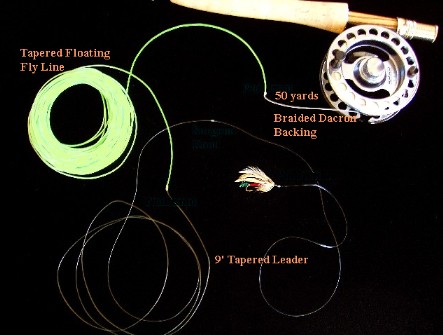
Equipment Basics
The basic fly fishing
equipment system is composed of a fly rod and a reel holding the fly line.
Behind the fly line, secured to both reel arbor and tied to the rear of the
line, is 50 – 100 yards of braided Dacron backing. A leader, commonly 9’, is
attached to the front end of the fly line. At the unattached fine end of
the leader a fly is tied. Add water and fish.
Rod Selection --- Know
Thyself
As explained in the Introduction, as a teenager
beginning my fly fishing career I had no clue there were any major differences
among fly rods other than that some were longer or shorter, thinner or fatter,
different colors, different prices. It did not occur to me that there
might be
specific fly rods for specific gamefish. No clue that the same fly rod for
pursuing bluegill might not be the same rod for fighting blue marlin.
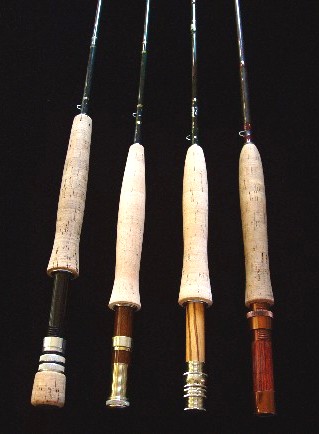
Commit to be a specialist as you
start. Focus on what fish you will initially try to catch on a fly. Crappie,
bluegill, perch, small bass, small trout? Trout of all sizes? Steelhead? All
sizes of bass? Salmon? Saltwater gamefish?
Time for the first of a couple
analogies. Though I am a hunter --- a hunter of fish --- I am not hunter who
uses a gun or rifle. However, I have a rudimentary understanding of different
weapons for different quarry. Upland game bird hunters use a shotgun which
sprays a high-speed rain of small buckshot for quail, chukars, and pheasants.
Deer and elk hunters use a high-powered rifle that shoots a single bullet accurately
at great distance to bring down a large animal. Large, at least, compared
to the aforementioned birds. A hunter is called in on a humanitarian mission
to dispatch a rogue elephant, weighing several tons, that is trampling African
villagers. He will use a rifle that fires a monstrous caliber slug.
Now, the elephant rifle could be
used to hunt a hapless quail, but little would remain for dining purposes.
Conversely, a standard shotgun blast using a conventional shotgun shell will do
little, if anything, from a hundred yards to a deer or elk. Even at close
range, a shotgun assault on an elephant will probably guarantee that the shooter
becomes a flattened statistic.
Until the rules are changed whereby
golfers must run after their golf ball, then do ten pushups before the
next shot, the game holds little fascination for me. But I do understand this
game where physical conditioning is totally optional, where weaklings and the
flabby can ride in carts to pursue their slices and hooks all day with little
corporeal challenge. Here comes the analogy I promised.
A golfer carries a bag of clubs. There are wood
drivers, an assortment of irons, a wedge or two, and a putter. Imagine
using a single club to play an entire 490-yard, par 5 hole. Let’s select a
putter. Instead of driving the ball 250 yards off the tee, you manage 50.
Now, envision a few problems with the
putter in the rough, in the sand traps, and attempting to loft a long shot over
the water hazard. Get the idea?
Over many years of running a fly
fishing shop I encountered would-be fly fishermen (a gender-general term
hereafter) who wanted me to help them select an all-purpose rod designed to
catch anything that swims. A tool for enjoying small fry from the farm pond, to
bruiser chinook salmon that might top 40 pounds. No such rifle. No such golf
club. No such fly rod.
Fly rods can be found in lengths
generally ranging from 6’ to 15’. Look hard enough you can find probably find
ones even shorter and even longer. There is no direct correlation between a
rod’s length and the species that it can handle. A 15’ two-handed spey fly rod
is not intended for pursuit of a 500 pound billfish. It is best suited for
salmon and steelhead that may range, typically, from 6 to 25 pounds. The length
of a general-use saltwater big game rod is around 9’. You might also select a
different 9’ rod that is perfectly suited for small trout and panfish.
Here’s how to envision the difference. Think of a willow branch and a billiards cue stick of the
same length with line guides on them.
The best clue you have about
the targeted intent of a quality fly rod built in the 1970’s up to the present
is written on it. If you examine the portion of the rod just above the
cork grip (“handle”), an inscription there will indicate either blatantly, or in
an easily deciphered code, the intended fly line “weight” to be used on the rod. This will be the
fly line that causes the rod to bend properly as it extends the fly line fully
and gently upon the water.
Fly line “weights” range from 0 to
14. What follows is a chart and the “most appropriate” gamefish typically
sought:
0 - 3-weight line/rod
panfish, small trout
4 - 6-weight
line/rod trout, summer steelhead
7 - 9-weight
line/rod bass, steelhead, salmon, bonefish, smaller saltwater
species
10-weight
line/rod heavy salmon, saltwater
11 - 14-weight line/rod tarpon,
large saltwater fish often exceeding 100 lb.
If you anticipate a
question you may be asked during the world championship Trivial Pursuit
competition about the actual physical weight of a give fly line “weight”,
or you just want to know in order to dazzle your friends at a party, here goes.
As fly fishing equipment
evolves, standards may be slightly adjusted. So, know that the numbers cited
here may change (or have changed) as a result, and are, therefore,
generalizations. Only the tapered portion --- typically 30’ – 40’ --- of a fly
line is weighed to determine the designated weight of a fly line. The actual
weight measurement is calculated in grains. 437 ½ grains = 1 ounce. A partial
table follows.
Line weight number Weight
range (grains) Rounded Average (grains)
1
54 - 66 60
2
74 - 86 80
3
94 - 106 100
4
114 - 126 120
5
134 - 136 140
6
152 - 168 160
7 177 – 193 185
8 202 – 218
210
Rather boring stuff, but
now you know. Let’s move on.
Most fly anglers fish
streams, and usually for trout. Unless you are going to be a BIG trout
specialist, in pursuit of the occasional summer steelhead, a 9’ 5-weight rod is
considered the best all-purpose combination by most of several thousand fly
anglers I’ve dealt with selling fly rods for 20 years. If you intend to be
a small stream / small fish specialist, an 8’ to 9’ 4-weight rod is pleasant.
Even a small fish will put a lively bend in a 4-weight. A 9’ 6-weight is
an excellent choice if summer steelhead are part of your fishing mix, even
though trout are your main focus.
Why a 5-weight? A
4-weight rod does not perform as well in the wind, nor does it handle weighted
flies or long casts as well as a 5-weight. A small trout, which we all
catch in most streams, has to pull very hard against a 6-weight to impress you
with his fight. Fishing a light leader with a small fly on a heavier rod,
the angler is more likely to break off a fish on the strike or during the fight.
A hook-set with a more powerful rod generally translates into a more powerful
impact on leader and fly. Too, a larger diameter fly line may dictate a
bit larger, heavier reel for your six-weight system. It won’t be as
feathery light as a 4- or 5-weight.
Some anglers are enamored with the
thought of landing a large fish on an extremely light (“ultralight” is the word
commonly used, especially by my spinning rod brethren) rod/reel/line
combination. Can it be done? Yes. Can it be great fun? Yes. Can it do harm
to the fish, even kill it under the right conditions? Yes.
Time for a little science. As water
warms it is less able to hold dissolved oxygen. Fish, like us, need oxygen. It
is extracted from the water and introduced into the fish’s bloodstream as the
water passes through the gills. If the water is dangerously warm --- let’s say
68 – 75 Fahrenheit degrees for a stream trout --- a fish played for a long time
after initially being hooked can get so exhausted it will be unable to recover,
unable to extract enough dissolved oxygen from the water quickly enough to
survive. Imagine someone threatening to shoot your dog unless you consent to
run a marathon at an elevation equivalent to that of Mt. Everest. You’re gonna
die! So, a rod matched to the size of the fish being sought, makes good sense.
If the water is warm in late summer and fall, play your fish quickly --- within
reason --- to minimize its exhaustion. An ultralight rod, because you usually
cannot exert as much forceful tension on the fish, may overtax and kill it.
Not all fly rods are created
equal. Some definitely have better pedigrees, and for that reason perform
better, look nicer and cost more. You will find graphite fly rods ranging
in price from $29.95 to more than $700. What’s right for you?
First of all I want you to dispel a
very common, and virulent, line of logic from your thinking. So often I’ve
heard novices say something like, “I’ll get a cheap rod to get started with /
learn with, and then move up to good equipment.” This is totally backwards.
Someone with minimal skills and experience needs a better tool, not a
poor one, a toy. Assuming it is matched with an appropriate fly line, a good
rod will encourage and accelerate your learning. Casting will be fun and easy
once you have a little casting instruction. Your line and leader won’t always
land in a heap. Learn from my mistakes!
Realistically establish your
rod budget. My suggested minimum --- take it for what it’s worth --- is
$100. Is it better to buy an inferior rod and struggle as I did to make it
work? You may not be able to overcome the discouragement, soon giving up
on the sport. Or, it may mean you will have wasted your initial investment
and have to buy the good rod you should have bought in the first place.
Wait, if necessary, until you save up the needed cash. You only have to
buy the right rod once.
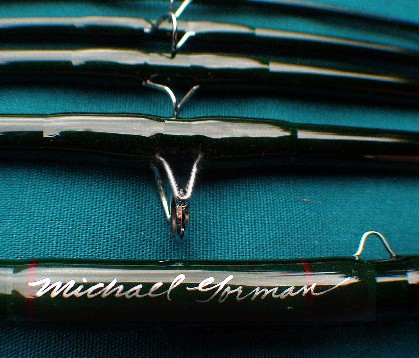
Get a reputable brand name rod, and the best you can afford.
If you can’t cast it first, don’t buy it. Ask about a guarantee.
Some rods have them, and some do not. You will pay more for a rod with a
no-fault breakage warranty, but it can be well worth it. Some careless or
unlucky anglers break a rod every year. They need a guarantee. 90
days or one year is not enough. Get a minimum 25-year guarantee.
Lifetime is better.
Choices, choices, and more
choices. When I first took up downhill skiing I did not have a very good
idea about what skis I should by. Every salesperson had their suggestions,
and there was no recurring theme. So the first few times I went skiing I
rented skis . . . and watched. I watched the better skiers. In
particular I looked at the brand names on their skis. A small handful of
names predominated. My choices were narrowed and I purchased some good
skis that have served me well.
You can do the same basic detective
work with fly rods, or any other piece of fly fishing equipment for that
matter. Whether in a fishing store or along a stream, ask veteran skilled
anglers what they use. The more sources you consult the greater the odds you
will see several brand names rise to the top. Know that any given rod
manufacturing company has a variety of rod models at a variety of price points.
Going into the car dealership and you would not say, “I want a black Ford with
air conditioning.” You specify Thunderbird convertible. The same is true for
ACME fly rods. Specify the Graphite III Trout Turbo series.
Novices are shy about casting in
public. They also reason that they could not distinguish one rod from
another. I disagree. Insisting the angler should cast a variety of rods ---
same length, same line weight --- side by side, I have found to always be
enlightening for the caster. Besides giving them a mini casting lesson ---
which they always appreciated --- the rookie could get a “feel” for any given
rod, even if the casting technique was poor. The particular unique timing of
the rod bend, the lightness or heaviness of the rod, the shape and comfort of
the cork grip, even an appreciation or dislike of the rods aesthetics all served
to give input to the wannabe fly angler. If one particular rod above all others
evoked a smile from the caster, the case was closed. That’s why I insist
everyone, in spite of skill level, should cast a variety of rods before the
final decision. This is accepted protocol at better fly shops and sporting goods
stores.
Math time. A simple test that
should be passed by all quality fly rods: the number of guides, not counting the
tip top, should equal a number one more than the whole number of feet in the
rod’s length. For example, a 9’ rod should have a minimum of 10 guides. An 8’
or 8 ½’ (drop the fraction) rod should have a minimum of 9 guides. Inferior
brands usually violate this simple rule of thumb. It costs them more in time
and money to get it right. Count the guides!
EVERY fly fishing rookie I have ever
encountered hails the myth that all bamboo rods are special and valuable.
Hundreds of times I’ve heard from the smilingly proud purchaser: “ I found this
at a garage sale. I only paid $4 for it! What do you think it’s worth?” After
I examine the vintage stick that most likely has a crooked tip, guides that are
rough with corrosion, and too small for modern fly lines, I do my best to avoid
a direct response to the “How much is it worth?” question. Instead I talk a
little about art, specifically great painters Rembrandt, Monet’, Picasso, et
al. Anyone with a brush can paint on canvas or paper. The signature of an
acknowledged talent on a painting can add great value to a technically fine
piece of art. In the same way, a fine bamboo rod will bear the signature of a
great rod building craftsman. If it does not then the tool most likely does not
have great monetary value, and is probably not a great fishing tool. I phrase
all this in such a way as not to hurt the feelings of the rod owner. Then, I
test their resolve. In an upbeat manner, I tell them what must be done to
renovate the rod to fashion it into a quasi-functional fishing tool. When I
suggest to the owner that he will have to strip and refinish the blank, then
replace and, possibly, relocate the guides, they start to understand that the
rods 50 and 60 years past are rarely the best choices to fish in light of modern
tools. Most eventually acquire a graphite rod, and will fish more effectively
for doing so.
Fly Lines
--- Land of Confusion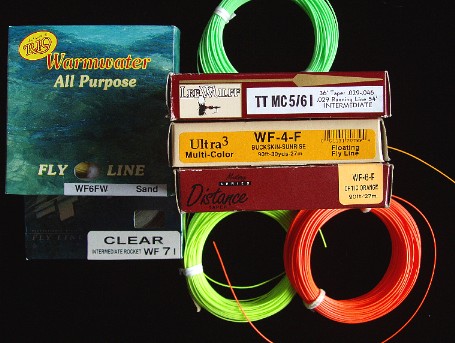
My first fly line cost
98 cents: a forest green piece of string that always landed in a heap when I
cast it, unless I had a strong tailwind. It took me years to discover that most
fly lines are tapered. How are you with some of the basic principles of
physics? When a tapered line is properly cast, the transfer of momentum
(p = mv) is passed smoothly along the length of the fly line causing it to
unfurl on the final forward cast. The line lays out fully extended on the
water. As you might now suspect, mine was of the taperless variety. (mv +
taperless fly line = a coiled mess = lousy presentation of the fly +
frustration)
To keep it simple, there are essentially two fly line tapers: double taper and
weight forward. Most of my beginning students have heard of the double
tapered fly line. Those who have purchased a line with little or no
knowledgeable counsel have purchased a double tapered fly line. This, most
likely, is not the best choice for a fly
angler’s first line, though it is a quantum leap better than my initial purchase
with no taper.
A
double taper fly line is, typically, 82 to 90 feet long. As
the name would imply, the line gradually decreases in diameter over a length of
about 30 feet at each end. The midsection, or belly, is about 25 to 30
feet long.
Assuming the line is
cast with some modicum of skill, here are the advantages of a double taper:
1.
The line and fly are presented very softly, delicately upon the water.
Minimum disturbance to the trout caused by line splash. If a dry fly is being
used, a delicate presentation decreases the possibility of a hard landing that
might sink the fly upon impact.
2.
The double taper is an excellent choice for roll casting. A roll
cast is used when the angler has a high bank, high grass, bushes, or trees to
his or her immediate rear. With a standard back cast, the caster risks breaking
off the fly. A roll cast alleviates the problem as the fly line passes barely
to the rear of the angler during the presentation. More on casting in a later
chapter.
3.
Economy. Because the double tapered line is tapered at both ends,
when the fishing end of the line has cracked and no longer floats (assuming it
is a floating line), merely pull the line off the reel and turn the line around,
re-attaching it to the backing, to fish the un-used tapered end.
Now, let’s contrast this
with the weight forward taper design.
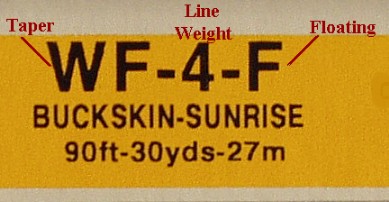
=====================================
Advantages of the weight forward taper:
1.
Distance casting. Though most fishing in streams and rivers is done at
close range --- 25 – 40 feet --- there are times that a longer cast must be made
to reach the fish. To increase the casting distance, the caster strips loose
coils of line from the reel which fall to the water or ground at the fisherman’s
feet. During the forward casting motion, the angler allows this coil, or coils,
of fly line to “shoot” through the rod guides in order to extend the cast. As
the slack line “shoots” (travels with velocity) through the rod guides there is
naturally friction between the line and guides. The less the friction the
farther the line carries to extend the cast. Because the running line portion
of the weight forward line has a relatively small diameter compared to
the mid-section, or “belly”, of a double tapered line, there is less friction.
This results in a longer cast with less effort.
2.
Casting into a breeze is a common occurrence in fly fishing. The weight
forward design is better able to pierce the wind and present the fly than the
double tapered line.
3.
Sooner or later the well-rounded stream angler is going to cast heavily
weighted nymphs or wet flies, and bushy air-resistant dry flies. Moving the
momentum of the cast along the full length of extended line and leader so that
the whole system rolls out in a fairly straight line presentation is best
accomplished with the weight forward design.
4.
Most beginners naturally start their casting practice and fishing at
short distance, inside 30’. A weight forward line “loads” (bends) the rod
tipper quicker at short distance than a double taper. It is the bend of the rod
that propels the fly line. Most anglers will agree that very short line casts
are more easily accomplished with the weight forward taper.
5.
The weight forward taper, though not quite as good as the double taper in
these regards, does a quite passable job of roll casting a fly, and can present
a fly with reasonable delicacy when required to do so.
For fly anglers seek
maximum opportunities --- short casts / long casts, big fly / little fly,
casting in the wind, reasonable capability of roll casting and delicate
presentation when necessary ---- the weight forward line is the better choice.
The double taper, though economical from the standpoint of being able to reverse
the line after wearing out one end, is more of a specialty line. This is
particularly true and important for the beginning or occasional angler.
There are fly lines that float.
There are fly lines that sink. There are fly lines that have a portion that
floats and a portion that sinks.
The sinking fly line has a specific
sink rate, ranging generally from 1 to 10 inches per second, or “ips”.
Fly lines also come in a variety of
colors. Floating lines are the most exciting. You can choose from muted olive
and tan to yellow, orange, vibrant green and fluorescent red. I love and use
colorful floating fly lines. This always leads to the question “Can fish
see color?” The answer: “They most certainly can.” Do they see red as we see
red, or blue as we see blue? I don’t know, but they can distinguish one
color from another. Just ask any experienced fly fisher who has presented a fly
to selective trout. The correct color can be the difference between success and
failure.
“Do brightly colored fly lines scare
the fish?” I am often asked. I believe it is the splash and shadow of a hi-vis
fly line that disturbs the fish, rarely the color. I would certainly get
rousing disagreement from some anglers on this point, especially from my friends
in New Zealand who are positively phobic about colorful fly lines. The Kiwis
insist that their trout are so wary that only a subtle olive, tan or brown fly
line should be used to fool them. Unfortunately, having fished more than a
dozen rivers there --- most multiple times --- on both the north and south
islands I have enjoyed great success in New Zealand with my gaudy fly lines, to
the gasping consternation of the Kiwi angling guides I have employed. The
stealthy approach, the angle and delicacy of the cast, and the appropriate
leader are of major importance. Fly line color is of little or no importance to
me with, perhaps, one very occasional exception. The trout are holding in flat,
shallow clear water. Circumstances dictate I must approach the trout from the
upstream position (fish hold facing upstream into the current). A dull colored
fly line makes sense if I am standing in bright sun and my
backdrop, as viewed by the fish, is in deep shadow. Besides me and my waving
casting arm being very visible, my fly line would be, too. That’s why you see
eye-catching photos of fly casting with the caster in the bright sun against a
darkly shadowed background. Maximum visibility.
For me being able to easily see my
fly line, even in dim light conditions, allows me to track my fly or its
proximity. Knowing the location of my fly allows for an accurate presentation.
While fishing, good visibility gives me the chance to react quickly to set the
hook, even when the take is very subtle. Sometimes the only indication a fish
has intercepted my fly is a very subtle hesitation or straightening at the tip
of the fly line. Lively colored lines make it easier for me to see such strikes
so I catch more fish. Any minor disadvantage here, in my mind, is greatly
outweighed by the plethora of plusses.
If you are going to have only one
line for fishing streams make it a weight forward floating line. Whether my
clients or I are fishing dry flies, wet flies in the mid-water column, or nymphs
along the stream bottom a floating line tops all other choices. Choose a color
that appeals to you in light of what I have written above.
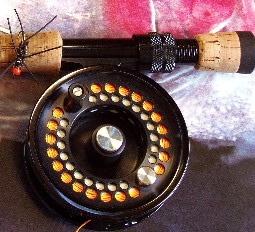
Reels
--- The Good, the Bad, and the Mediocre
Having taught fly fishing classes
for more than twenty years I hear some misconceptions over and over from
students. Some ideas I hear so often that they attain status as Common Fly
Fishing Myths. One of the Top 40 Common Fly Fishing Myths of All Time is that a
fly reel serves little more function than to store the fly line. It’s held in
low regard as a passive piece of equipment being little-involved in the catching
of fish. Wrong!
If one of your fly fishing goals is to never catch a stream trout over 12” then
perhaps you don’t need a good fly reel. However, I
am going to make the bold assumption that few anglers --- including you ---
don’t list this as one of your objectives. It is rare to discover
fishermen who have a disdain for larger fish, so on the certainty that you will
eventually encounter one on the end of your line get a good fly reel
to best insure you will land such a fish.
I do not recall ever witnessing
someone, myself included, losing a fish because the fly rod failed to perform as
it should during the fight. Beyond “pilot error” the leading cause of lost fish
in my experience is due to the malfunction or inadequacies of the fly reel. A
large trout (14” or more) swimming hard downstream with the current at its back
can pull fly line from a reel at a startling rate. If you should hook a trophy
trout, steelhead, or salmon the speed at which the line disappears from the reel
is now classified as “frightening”. If the line is not released smoothly,
and with adequate resistance (drag), the odds favor the fish escaping.
If not a scofflaw, you have auto
insurance. You probably have homeowner’s insurance, medical insurance, and life
insurance. Unless you are a scam artist you rarely use your insurance, perhaps
going years without filing a claim. If you crash your car when you have a heart
attack as you watched your home burn down you are glad that you have insurance.
The same analogy applies to a good fly reel. You may not need to call on its
full capabilities often, but its reliability is there when you need it. The
reel is part of your fly fishing insurance team.
Here are a few fly reel
suggestions.
Get a quality brand name
reel. Be careful here because well-known spinning reel and level wind reel
companies may build lousy fly reels. I suggest companies that specialize in
fly fishing gear. A fly shop would usually be a better scouting location
then a general sporting good store. Think of physicians who deal with specific
ailments. A family practitioner should not be your choice for heart surgery.
Deal with a specialist. That way you will only have to buy your fly reel once.
A smooth drag is extremely
important. There are a variety of designs. The spring-and-pawl and disc drag
models are the two most common.
During the proper function of a
spring-and-pawl reel, a triangular “tooth” (pawl) works against a gear on the
inside of the reel spool. The pawl’s backside lays against a linear spring.
Most reels of this type have an adjustable drag knob so that tension on the
spring may be increased or decreased, increasing or decreasing the amount of
drag. The spring-and-pawl drag has a relatively small tension range. With
inferior reels the range soon becomes even smaller as the spring weakens. Too
often springs break and pawls wear out. Replacement parts are a hassle. Some
reel makers include an extra spring and pawl when you purchase their reel. I
don’t know if this is thoughtful service or an admission of the reel’s fate. I
lean to the latter. As evidence I no longer own any spring-and-pawl drag reels.
However, my personal choices aside,
there are some adequate spring-and-pawl drags. For financial or other reasons
you may be fishing with a reel of this type. If you run the risk of hooking a
large fish in moving water perform this simple test. Set the drag to maximum
tension. Assuming the reel is loaded with fly line, grab the loose end of the
line and give a hard, quick yank to simulate a fish running away at high speed.
If you end up with a tangled bird's nest as the spinning spool “overruns” the line
then you have seen the future. The tangled line will jam, and your fish will
instantly break off. Another possibility is that the pawl will disengage from
the center gear. Yikes! However, if your reel passes this test it bodes well
for encounters with big fish.
The majority of fly reels have an
exposed spool rim. As the spool turns you can assist the reel’s drag by
lightly touching the outer portion of the spool with your finger or palm. Those
anglers with an inadequate drag are motivated to learn this quickly.
A disc-drag reel makes good sense
and a good investment for most fly anglers I encounter. In the simplest terms,
a disc drag is a system where two precisely machined surfaces lay flat against
each other. As line is pulled from the reel spool one circular surface --- the
disc --- turns against the smooth resistance of the stationary surface which
faces it. A drag knob allows the angler to increase or decrease the degree of
friction between the two surfaces. Tension can be increased to the breaking
point on most models, or decreased to a bare minimum. The right setting, of
course, is found somewhere in between. Taking into consideration the fish, the
flies, the breaking strength of the leader, and the skill of the fisherman, the
broad setting range of the disc drag reel is a highly desirable feature. As
competition in the market place grows there is a corresponding increase in the
number of quality, budget-priced disc drag reels available.
On any good reel it is nice to be
able to switch the direction of the drag. This allows you to retrieve line onto
the reel with the hand of your choice.
Here’s another Top 40 Common Fly
Fishing Myth: better fly anglers retrieve line by turning the reel spool with
their casting hand. A right-handed caster, for example, turns the reel handle
with his or her right hand. Once a fish is hooked the angler switches the rod
to the non-casting hand to fight the fish. You don’t have to do this, even
though Grandpa did!
Let’s talk about the origin of this
myth by going to Europe. I choose to lay most of the blame on the English since
they comprised most of the early settlers of America and, naturally, influenced
our traditional angling methods. Hundreds of years ago in Europe the wealthy
and royalty owned the good land, streams and rivers included. If you --- a
commoner --- caught a fish or killed a deer you were poaching. We all remember
Robin Hood poaching the King’s deer in Sherwood Forest.
When not hunting with hounds for
other game, the chosen sporting method for angling was fly fishing. Now it
seems the Brits, once a fish was hooked, chose to retrieve the line and fish by
stripping/pulling in the line by hand. They did not retrieve line onto the
reel, letting the line fall in loose coils at their feet. The last statistic I
read about dominant digits indicated that 93% of our global inhabitants are right-handed, so the great
majority of these anglers cast and held the rod in their right hands. The line
was, therefore, stripped/retrieved with the left hand. Common sense would
dictate that the reel handle was naturally on the left side of the reel. The
right hand is busy holding the rod.
Now, envision this. A bigger,
stronger fish being hooked and played by a Line Stripper may struggle mightily,
pulling hard on the line. If the angler does not give back some of the line the
tension may break off the fly. The angler attempts to smoothly release line
through his fingers letting the fish run. If you have ever done this you know
things can happen quickly. Loose coils of lines can tangle or get caught on
something as the fish reclaims the slack line, running away at high speed. As the
right-handed angler guided and released the line with the left hand on
the left side of the reel, one of the potential line-grabbing problems
was the reel handle. There was always a chance that a loose coil of line being
pulled by a fighting fish could inadvertently be wrapped around the handle.
Simple solution: put the handle on the right side of the reel so it is out of
the way, one less hazard to catch the line.
Even as we enter the 21st
century it is not uncommon that fly anglers switch the rod to the opposite hand
to retrieve line as they fight a fish. They were taught this way and will teach
their young the same. Risking controversy, I would wager most do not know why.
Reminds me of a story
. . . A young
housewife, preparing a holiday dinner, cut a few inches off the narrow end of a
whole, uncooked ham. She placed the ham in the roasting pan, then put it in the
oven to bake. Her daughter, watching the preparation, inquired as to why her
mother had cut off the end of the ham. Mom replied she did so because her
mother (the little girl’s grandmother) had always done so. Grandma, overhearing
the conversation, revealed to Mom that the only reason she had cut off the ham
end prior to cooking was because it would not otherwise fit into her undersized
baking pan.
For additional reading on the
handing down of traditions check out Shirley Jackson’s short story The
Lottery.
Any given fly reel model
usually is available in a variety of sizes. Which size is right for you? The
reel needs to accommodate your fly line and approximately 50 yards of backing.
There needs to be a comfortable amount (1/2”?) of room between the fly line and
the line guard on the reel. If the line and backing leave very little room on
the reel you end up with an annoying problem while you are fishing. As fly line
is retrieved it tends to pile up on one portion of the spool. There is no
mechanism other than your finger to evenly distribute the line across the spool
as it comes in. If the spool shows little capacity remaining when the line and
backing are initially put on, the problem will be magnified on the stream. Your
choices at that point include reducing the amount of backing, replacing the
backing with a smaller diameter, lighter strength backing, or cutting off a
portion of the rear, non-tapered section of fly line.
Another member of the fly fishing
insurance team is your fly line backing. You may not see your backing often but
when you do you will be glad it’s there when a memorable fish pulls all the fly
line from your reel and, then, wants more.
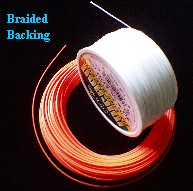 Choice of the right type
of backing is critical. Beginners ask me all the time if it’s okay to use
inexpensive monofilament spinning line for backing. Nope. Braided Dacron@ is
your best choice, for the following reasons: Choice of the right type
of backing is critical. Beginners ask me all the time if it’s okay to use
inexpensive monofilament spinning line for backing. Nope. Braided Dacron@ is
your best choice, for the following reasons:
1.
It does not stretch, unlike monofilament line. Backing that stretches
under the tension of fighting a big fish in heavy water and is subsequently
reeled onto the spool can exert a damaging force on the spool as the line seeks
to “relax” when the tension is removed. This problem will probably be minimal
for trout fishing, but can me a major one when playing salmon, steelhead and
larger saltwater species. I saw a reel spool filled with heavy monofilament as
backing actually damaged to the point of being unusable when an Alaskan salmon
was reeled in under great tension from a long distance.
2.
It is quite strong for its relatively small diameter. Because braided
Dacron@ takes up little room on the spool compared to a fly line, the angler can
minimize the size and accompanying weight of a larger reel.
3.
It does not readily deteriorate when exposed to the elements.
Monofilament exposed to sunlight weakens and deteriorates over time. Lubricants
and petroleum products from the fly reel that may come into contact with
monofilament may accelerate the process. Envision your monofilament backing
breaking as the fish of a lifetime swims away with your fly and fly line!
That’s why smart spin anglers replace the monofilament line on their spools
every year. I’ve had braided Dacron@ on some of my reels for more than 20 years
and it’s still in good shape.
Braided Dacron@ is
available in a range of strengths: 12 lb., 20 lb. and 30 lb. 20 lb. is the top
choice of most trout anglers. All are available in natural white, but some
brands are available in fluorescent green and fluorescent orange. It has been
my experience that the colored backings eventually bleed their colors onto the
fly line. This is not aesthetically acceptable to me, but if you like the
tie-dyed T shirt look on your fly line go for it.
Take Me to Your Leader
The transparent
terminal portion of your fly fishing system to which the fly is tied is the
leader. So as not to disturb the fish, the fly must be removed some distance
from the splash and shadow of a cast fly line. No matter that the fly line is
too large to fit through the hook eye of the average trout fly.
Early on I did not realize
that a leader is normally tapered, just as the fly line is. This enables the
casting momentum carried along the fly line to be transferred along the entire
length of the leader to extend the fly to the fish.
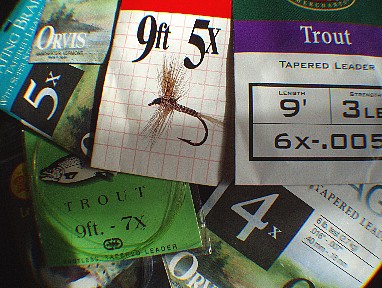
Though you can create your own
tapered leader tying together decreasing diameters of monofilament (or similar
modern material) line, it is easier to opt for knotless tapered leaders that are
extruded from a machine. Knots too often collect algae and vegetation in the
stream. It is irritating to be constantly cleaning the knots. If you fail to
do so, the leader may become evident to wary fish that may be alarmed by a
string of algae bits suspiciously hanging out in the vicinity of the fly. It’s
a little like spray painting the Invisible Man.
Leaders come in a variety of
lengths. The range runs from 3’ to 16’. Unless you have good reason to do
otherwise, select a 9’ leader. This length is suitable for most stream fishing
situations regardless of whether you are fishing nymphs, wet flies, or dry flies
with a floating fly line. The 9’ length is adequate for keeping the fly line
far enough removed from the fly so the fish are not spooked, but short enough
that the leader is easily coaxed to turn over, extending full length to present the
fly.
Here’s another fly fishing
vocabulary word: tippet. Often used incorrectly and interchangeably with
“leader”, the tippet is a very specific portion of the leader. It is the
non-tapered terminal portion of the leader to which the fly is tied.
When I spoke of the tapered leader I
failed to mention that it is not tapered over its entire length. The thick end
of a typical trout leader may measure 0.024” diameter. Over the next 6 ½’ to 7’
the taper smoothly scales down to a final diameter of, perhaps, 0.007”, for the
sake of example. Depending on the manufacturer, the final 20” to 30” of the
extruded tapered leader has a uniform diameter of 0.007”, the tippet.
Mathematically speaking, the tippet is a subset of the leader.
But I Hate Math!
I love math. I
taught secondary math. But even if you are not a numbers whiz, this is simple
math, and very important to your success. Nine-foot leaders have an array of
tippet diameters to choose from. That’s why I tried to emphasize that 0.007”
tippet diameter used previously was just an example. And, please note, I will
be writing about tippet diameters, not tippet strengths. You will find
out why later.
To cast and drift naturally, a fly
must be matched to a tippet of the appropriate diameter. If the diameter of the
tippet is too small relative to the size of the fly, the transfer of the cast’s
momentum may not pass along the entire length of the leader. The fly “load” is
too heavy or air-resistant. The leader collapses in a heap rather than
extending its full length during the cast.
If the tippet diameter is too large
for the fly you may not be able to get the tippet through the hook eye. To make
my point let’s pretend that we can get an oversized tippet through the eye and
the fly tied in place. There will be no problem with turning over the leader at
length. The problem arises as the fly drifts in the current. It will not look
natural. It will act like it’s attached to a stiff invisible cable. The fly
will not drift or swim naturally. This can seriously decrease your angling
success.
Tippet diameters have an unusual
designation. Rather than being commonly referred to by their measurable
diameter in inches, or feared and repulsive millimeters, they are referenced in
“X” numbers: 0X, 1X, 2X, and so on. This “X” number will be prominent when you
look on a leader package as you try to determine which leader to buy. With
minimal boring details here, suffice it to tell you that once upon a time
leaders were made from silkworm gut. Gut was fairly strong and lent itself to
being cut into successively smaller diameters if you had the right cutting
tool. If a strand of gut that measured 0.011” inches was trimmed down once ---
one time or “1X” --- the strand was reduced by 0.001” to the new, smaller
diameter of 0.010”. If the same strand was cut down a second time --- 2 times
or “2X” --- it was reduced an additional 0.001” to now measure 0.009”. cut down
a third time --- 3X --- the strand was now 0.008”. See the trend? I promised
you this would be simple math. I’ll put this info in table form and it will
reinforce the simplicity.
Tippet Diameter
“X” number diameter in inches
0X 0.011”
1X 0.010”
2X 0.009”
3X 0.008”
4X 0.007”
5X 0.006”
6X 0.005”
7X 0.004”
8X 0.003”
Note that there is an
“inverse relationship”. The larger the “X” number, the smaller the diameter.
The smaller the “X” number, the larger the diameter. The diameter of a 6X
tippet is smaller than the diameter of a 1X tippet.
The math lesson continues. All
this has led up to an equation that will help you determine the correct diameter
leader/tippet for any given size trout fly.
Fly hook
size
size 12
---------------- = “X” number Example
--------- = 4X
3
3
Not all hook sizes can be
divided evenly by 3, so approximate the best answer. For example, a size
16 fly would be best presented on a 5X leader. Both sizes 8 and 10 flies would
be best cast and fished on a 3X leader.
Leadership and the Economy
It’s going to
happen. Sooner than later you will break off a fly, and another, and another.
Trees, grass, submerged limbs and stream-bottom rocks. A wily fish may break
your leader. All these serve to shorten your leader. Changing flies of your
own volition cuts away at the leader. What one was once 9’ has been shortened
to 7’ or 8’. Your original tippet, or most of it, has disappeared.
You have a couple of choices. One
is to replace your old leader with a new one. The cost will range from $3 to
$4. Your second choice is to extend the leader by using a surgeon’s knot to tie
a fresh section of tippet to the leader remnant. For the sake of economy, time
and versatility the second course makes excellent sense.
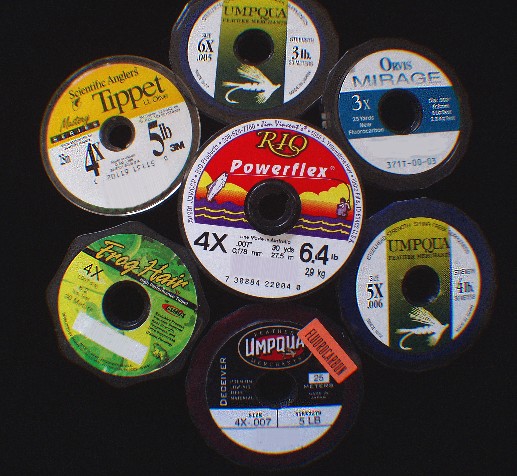
Tippet line comes on small put-em-in-your-pocket
spools. The best ones have a stretchy band covering the coiled line so it does
not unravel from the spool, presenting you with a pocketful of loose, tangled
mess. Carry a selection of diameters. Trout anglers will most often carry
spools of 3X, 4X, 5X, and 6X tippet. These diameters have proven most useful
for the trout fly sizes commonly used.
In addition to the leader already
tied to the fly line, it is wise to carry spare leaders. Until your personal
experience tells you otherwise, carry an extra 3X, 4X, 5X, and 6X nine-foot
leader. These will accommodate flies ranging from size 18 up to size 8.
If I change fly size must I always
change the tippet, too? It is reasonable in many cases to fish a tippet size
that is either ONE tippet size too large or too small than our mathematical
equation calls for. Personally, I am less concerned about fishing a tippet that
is one diameter too small for the hook size than I am about fishing a tippet
that is too large for the hook size. This is especially true in flat,
un-riffled water where a stream trout gets a good look at how my fly is drifting
with the current. A larger diameter tippet is a bit stiffer and adversely
affects the “swimability” of the artificial. In fact the trout in flat water
may be so wary that sometimes it may be mandatory for the angler to fish
a fly on a tippet that is one size smaller than the recommended ideal. If the
water is choppy, the fish’s vision is some what obscured. A slightly heavier
tippet probably has little affect.
Here’s another situation. Suppose
you are fishing a 3X tapered leader (this means that the tippet of the tapered
leader is 3X), and you wish to fish a size 18 fly. A size 18 hook is best
presented on a 6X tippet. So, is it reasonable to tie a section of 6X tippet to
the 3X tippet? I would not, for two reasons. The knot between two diameters of
such relatively big disparity may not hold secure. Secondly, the leader may
“hinge” or collapse at the knot. The 6X tippet may not lay out, collapsing in a
pile of little coils. The momentum of the cast has not transferred smoothly all
the way to the fly. The solution is to splice in 6” – 8” of 4X or 5X tippet
between the 3X and 6X. In my experience I can step the added tippet down one or
two diameters when splicing it to my leader, but not three or four jumps in
diameter difference. When splicing additional tippet to a leader, be cognizant
of the final leader length. In order not to create a leader that is too long
--- let’s say more than 10’ --- some (12” - 15”) of the 3X tippet on the
original leader may have to be cut back a bit before joining two more diameters
in this example. The section of tippet to which the fly is finally tied should
measure about 24”.
The hypothetical situations
continue. Suppose you are fishing a 6X leader (the tippet of the tapered leader
has a 6X diameter), and you want to tie on a size 12 fly. Does it make sense to
tie a new section of 4X tippet to the 6X? Usually not, because a collapsing
“hinge” may occur at the knot. Momentum is not transferred all the way to the
fly. It lands in a heap of 4X tippet. Better to, initially, cut off all of the
6X tippet and a little of the tapered leader behind it, then join the 4X
tippet. Ideally, you would cut the leader back to where the diameter was the
same --- or even slightly larger --- than the 4X tippet being added. Tie on
enough tippet to extend the leader to its original 9’ length.
A chemistry lesson
We’ve already had lessons in fly fishing
physics and math, and now it’s time for chemistry. Specifically, we are going
to discuss the chemistry of leaders and tippets.
There are three basic
materials from which leaders and tippets are commonly made: monofilament nylon,
co-polymer resin and PVDF (polyvinylidenfluoride), or simply “fluorocarbon”. At
first look all the materials appear the same, but using them as you fish
distinctions will become more obvious.
Monofilament nylon has
been in general use post WWII. Its relative “invisibility” compared to its
predecessors made it quite desirable. This was the leader material of choice
Furthermore, for making fly fishing leaders nylon monofilament could be extruded
from a machine in such away as to precisely control the creation of a smooth
taper. Monofilament was, and is, widely available and inexpensive.
In the early 1980’s a
new chemistry began to dominate the leader and tippet scene. Co-polymer resins
produced leaders and tippets that looked like monofilament but were up to 50%
stronger and suppler. An angler could use leaders/tippets of a smaller diameter
when desired, but give up nothing in breaking strength. Also, a supple tippet
enables a fly to drift more naturally in the current, with less of a hint that
the artificial was attached to anything. For these benefits the angler has to
pay 40% - 50% more at the cash register. Most think the cost well worth it.
Ten years later
“fluorocarbon” leaders and tippets became the rage for those willing to pony up
the price, generally 2 ½ to 3 times the cost of co-polymer items. For the same
diameter, co-polymers were stronger, but the fluorocarbon proved significantly
more abrasion-resistant. Alone, this does not warrant the price. But, by the
magic of chemistry, this new wonder material has a specific gravity greater than
that of water and a refractory index that causes it to “virtually disappear” in
water. The increased specific gravity enables the line to break the surface
film and sink, thereby not casting a shadow like monofilament or co-polymers
that tend to ride on the surface film. Fluorocarbon leaders and tippets are
more resistant to deterioration by UV (ultraviolet) light exposure, and do not
absorb water to the point of weakening and becoming more visible like some
co-polymers. At the turn of the new century, we are seeing fluorocarbon
chemistry improvements that have served to increase the breaking strength of the
material, too.
I can read your mind.
Is fluorocarbon worth the extra cost? Yes, with conditions. If the water is
very clear and the fish wary, fluorocarbon can be the difference between success
and failure. In clear lakes and ponds, for me there is no other choice. For
the budget route, cut the tippet off a standard co-polymer leader and replace it
with a fluorocarbon tippet. A carefully-tied, lubricated (with saliva)
surgeon’s knot allows for a secure splice of co-polymer material to
fluorocarbon, especially if the diameters are similar.
There should be a
warning label on each fluorocarbon leader package and tippet spool. “Warning!
The use of fluorocarbon can be habit-forming and hazardous to your pocketbook.”
We all have our little addictions. This is one of mine. Once you try
fluorocarbon leaders and tippets there may be no turning back . . . at least
until the next breakthrough in fly fishing chemistry.
Assembly Required
The ideal knot is simple, fast to tie, strong, and can be
tied without a tool. This narrows the field considerably. You need
to know three for fly fishing. You wannabe Knotmeisters can add more to your
repertoire. Tie your self silly, but start with these four, one of which you
may tie only once in a blue moon. This leads me into our astronomy lesson,
which may have little to do with fly fishing until you read my book on
fly fishing lakes, where the moon definitely seems to be important in your
fishing success.
A blue moon is a seldom
occurrence. With the exception of February, which really messes things up every
fourth year, there are 30 or 31 days in a month. A full moon usually occurs
once every 30 calendar days, but sometimes only 29 days. When a single calendar
month has two full moons in it, which doesn’t happen very often because of the
messy math, the second occurrence is referred to as a “blue moon”. Now, back to
the knots.
Here are the three ----
Tube / Nail knot --- used to tie braided backing to the rear of the fly line,
and
tie the leader to the front of the fly line.
Surgeon’s
knot --- used to splice more tippet to the leader.
Clinch
knot --- used for tying the fly to the tippet.
Know that there are
alternatives and “improved versions” to all these knots. My goal is to keep it
simple. I want secure knots that I can tie in the field, no tools required.
Thus, my selection. Save fishing time and frustration by practicing these knots
with warm fingers at home under a bright light. There’s a little ditty to help
pass the time as you practice. It serves to reinforce the message.
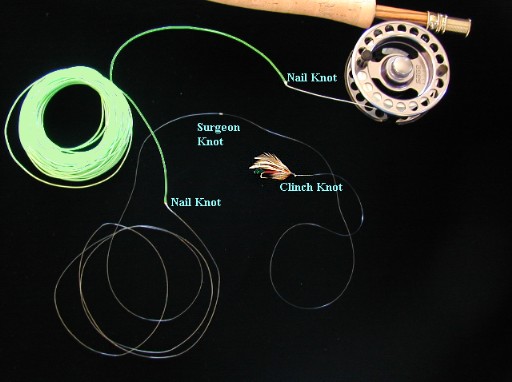
Sing Along
Pretend you are gathered around an open fire with
your friends on a fly fishing trip. Get in the spirit of the moment, or have
another drink. This is sung to the tune of “Row, Row, Row Your Boat”.
Know,
know, know your knots
Quickly
on the streams.
The more know the less you tie,
To catch the fish of your dreams.
(Second verse same as the first.)
Mr. Gorman has left the
building!
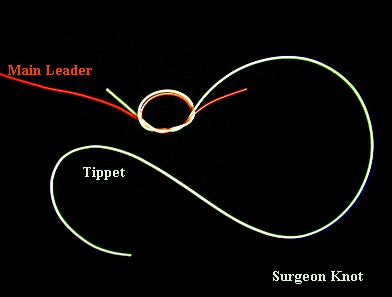
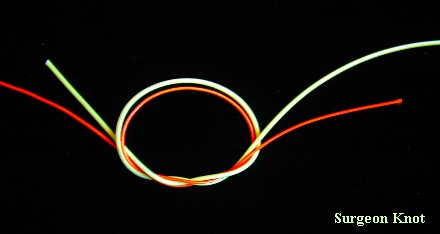
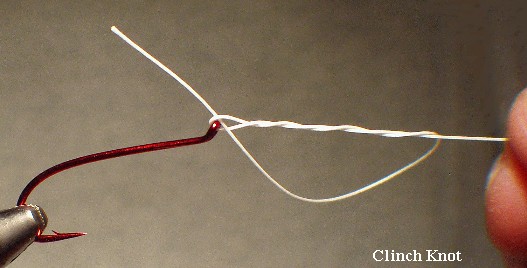
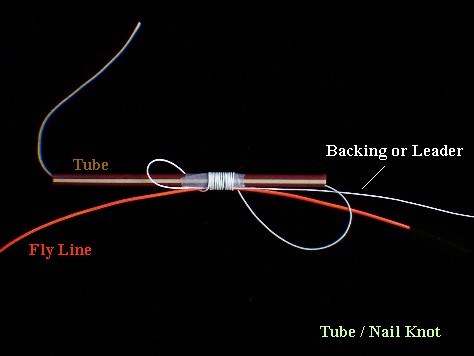
|